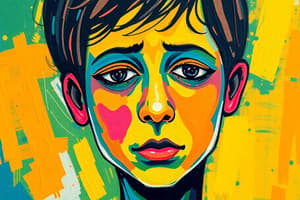Podcast
Questions and Answers
What is one key characteristic of selective mutism as described in the diagnostic criteria?
What is one key characteristic of selective mutism as described in the diagnostic criteria?
- Being unable to communicate in any form across all environments
- Expressing thoughts clearly but choosing not to communicate verbally
- Consistently speaking in all social situations without hesitation
- Failure to speak in specific social situations where speaking is expected (correct)
Which of the following best describes a specific phobia?
Which of the following best describes a specific phobia?
- An intense fear that occurs only during social gatherings
- A general and diffuse anxiety without a clear trigger
- An irrational fear that is not recognized as excessive by the individual
- A marked fear of a specific object or situation resulting in avoidance (correct)
What is a key prerequisite for diagnosing selective mutism according to the provided criteria?
What is a key prerequisite for diagnosing selective mutism according to the provided criteria?
- The disturbance must last for at least 3 months
- The failure to speak must persist for at least 1 month (correct)
- The failure to speak must occur in all social contexts
- The lack of spoken communication must be due to a language barrier
What distinguishes specific phobia from generalized anxiety disorder?
What distinguishes specific phobia from generalized anxiety disorder?
Which of the following statements about the developmental aspect of selective mutism is true?
Which of the following statements about the developmental aspect of selective mutism is true?
In regards to specific phobia, which of the following criteria indicates the severity of the fear experienced?
In regards to specific phobia, which of the following criteria indicates the severity of the fear experienced?
What is an example of how a child may express fear related to a specific phobia?
What is an example of how a child may express fear related to a specific phobia?
What duration of symptoms is necessary for a diagnosis of agoraphobia?
What duration of symptoms is necessary for a diagnosis of agoraphobia?
Which of the following is NOT one of the situations marked by fear or anxiety in agoraphobia?
Which of the following is NOT one of the situations marked by fear or anxiety in agoraphobia?
What is a common behavioral response observed in individuals with agoraphobia?
What is a common behavioral response observed in individuals with agoraphobia?
What is the relationship between panic disorder and agoraphobia?
What is the relationship between panic disorder and agoraphobia?
Which factor is associated with a higher prevalence of agoraphobia?
Which factor is associated with a higher prevalence of agoraphobia?
What is a key characteristic of specific phobia as defined in the diagnostic criteria?
What is a key characteristic of specific phobia as defined in the diagnostic criteria?
What does 'the fear or anxiety is out of proportion to the actual danger' imply in the context of agoraphobia?
What does 'the fear or anxiety is out of proportion to the actual danger' imply in the context of agoraphobia?
Which of the following is NOT a recognized type of specific phobia?
Which of the following is NOT a recognized type of specific phobia?
Which symptom is commonly associated with agoraphobia?
Which symptom is commonly associated with agoraphobia?
Which of the following conditions is characterized by avoidance behaviors in response to anxiety-provoking situations?
Which of the following conditions is characterized by avoidance behaviors in response to anxiety-provoking situations?
Social anxiety disorder primarily involves an intense fear of what?
Social anxiety disorder primarily involves an intense fear of what?
How long must symptoms persist for a diagnosis of specific phobia?
How long must symptoms persist for a diagnosis of specific phobia?
What distinguishes agoraphobia from a general anxiety disorder?
What distinguishes agoraphobia from a general anxiety disorder?
Which of the following best differentiates social anxiety disorder from general shyness?
Which of the following best differentiates social anxiety disorder from general shyness?
In the context of specific phobia, which situation would likely NOT be categorized under 'situational' phobia?
In the context of specific phobia, which situation would likely NOT be categorized under 'situational' phobia?
What distinguishes generalized anxiety disorder from specific phobias?
What distinguishes generalized anxiety disorder from specific phobias?
Which of the following is a common fear associated with social anxiety disorder?
Which of the following is a common fear associated with social anxiety disorder?
Which condition is characterized by avoiding situations where one might experience panic-like symptoms?
Which condition is characterized by avoiding situations where one might experience panic-like symptoms?
Flashcards
Selective Mutism
Selective Mutism
A condition where a child consistently fails to speak in certain social situations, but speaks in others.
Social Situations
Social Situations
Specific settings where speaking is expected (e.g., school, class, etc.).
Specific Phobia
Specific Phobia
An excessive fear of a particular object or situation.
Phobic Object/Situation
Phobic Object/Situation
Signup and view all the flashcards
Disproportionate Fear
Disproportionate Fear
Signup and view all the flashcards
Avoidance
Avoidance
Signup and view all the flashcards
Diagnostic Criteria
Diagnostic Criteria
Signup and view all the flashcards
Specific Phobia Duration
Specific Phobia Duration
Signup and view all the flashcards
Specific Phobia Impact
Specific Phobia Impact
Signup and view all the flashcards
Specific Phobia Exclusion Criteria
Specific Phobia Exclusion Criteria
Signup and view all the flashcards
Animal Phobia Example
Animal Phobia Example
Signup and view all the flashcards
Natural Environment Phobia Example
Natural Environment Phobia Example
Signup and view all the flashcards
Social Anxiety Disorder Definition
Social Anxiety Disorder Definition
Signup and view all the flashcards
Social Anxiety Disorder vs. Shyness
Social Anxiety Disorder vs. Shyness
Signup and view all the flashcards
Common Social Anxiety Fears
Common Social Anxiety Fears
Signup and view all the flashcards
Physical Symptoms of Social Anxiety
Physical Symptoms of Social Anxiety
Signup and view all the flashcards
Agoraphobia Duration
Agoraphobia Duration
Signup and view all the flashcards
Agoraphobia
Agoraphobia
Signup and view all the flashcards
Common Agoraphobia Situations
Common Agoraphobia Situations
Signup and view all the flashcards
Panic Attacks and Agoraphobia
Panic Attacks and Agoraphobia
Signup and view all the flashcards
Agoraphobia and Panic Disorder
Agoraphobia and Panic Disorder
Signup and view all the flashcards
Agoraphobia and Gender
Agoraphobia and Gender
Signup and view all the flashcards
Agoraphobia Avoidance
Agoraphobia Avoidance
Signup and view all the flashcards
Public Transportation & Agoraphobia
Public Transportation & Agoraphobia
Signup and view all the flashcards
Agoraphobia and Social Impact
Agoraphobia and Social Impact
Signup and view all the flashcards
Study Notes
Anxiety Disorders
- Anxiety is defined as apprehension over an anticipated problem.
- Anxiety is the main feature of anxiety disorders.
- Anxiety disorders manifest through excessive fear and anxiety-related behavioral disturbances.
- Many anxiety disorders develop in childhood and tend to persist if untreated.
- Anxiety disorders are diagnosed when no other explanation for the fear/anxiety exists.
- Anxiety disorders occur more frequently in females than males.
- Fear is an immediate alarm response to a perceived threat.
- Anxiety, a vague sense of danger, shares similar physical symptoms with fear, such as increased breathing and perspiration.
- Anxiety disorders have specific diagnostic criteria outlined in the text.
Types of Anxiety Disorders
- Separation Anxiety Disorder: Individuals experience extreme anxiety when separated from home or loved ones. Children with this may refuse to leave home or have tantrums, and adults may have extreme worry about the health/safety of others.
- Selective Mutism: Persistent failure to speak in specific social situations despite speaking in others.
- Specific phobia: Marked fear or anxiety about a specific object or situation, such as flying, heights, animals, etc.
- Social anxiety disorder: Marked fear or anxiety about one or more social situations in which the individual is exposed to possible scrutiny by others.
- Panic disorder: Recurrent unexpected panic attacks accompanied by physical symptoms and worries about future attacks.
- Agoraphobia: Anxiety about situations in which escape might be difficult or help unavailable in case of panic-like symptoms.
- Generalized Anxiety Disorder: Excessive worry and anxiety about various events or activities persisting for a long time.
- Substance/medication-induced anxiety disorder: Anxiety caused by substance use or certain medications.
Diagnostic Criteria for Anxiety Disorders
Detailed diagnostic criteria are provided for each specific anxiety disorder. They outline the essential elements of a diagnosis, including specified durations, and situations requiring particular attention. These criteria can vary across the listed disorders.
Studying That Suits You
Use AI to generate personalized quizzes and flashcards to suit your learning preferences.
Related Documents
Description
Test your knowledge on selective mutism and specific phobia with this quiz. Analyze key characteristics, diagnostic criteria, and developmental aspects of these conditions. Understand the differences between specific phobia and generalized anxiety disorder to enhance your learning.




